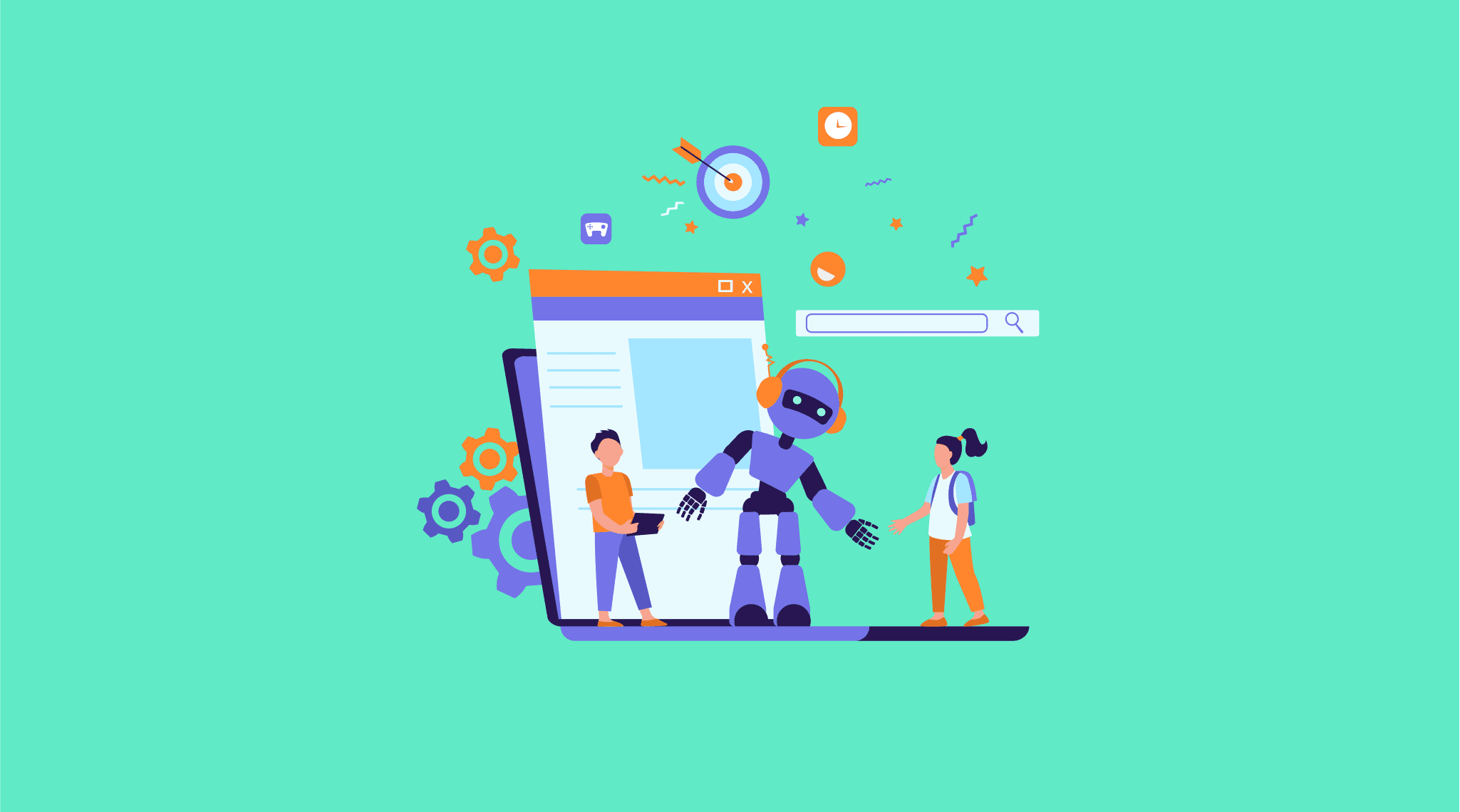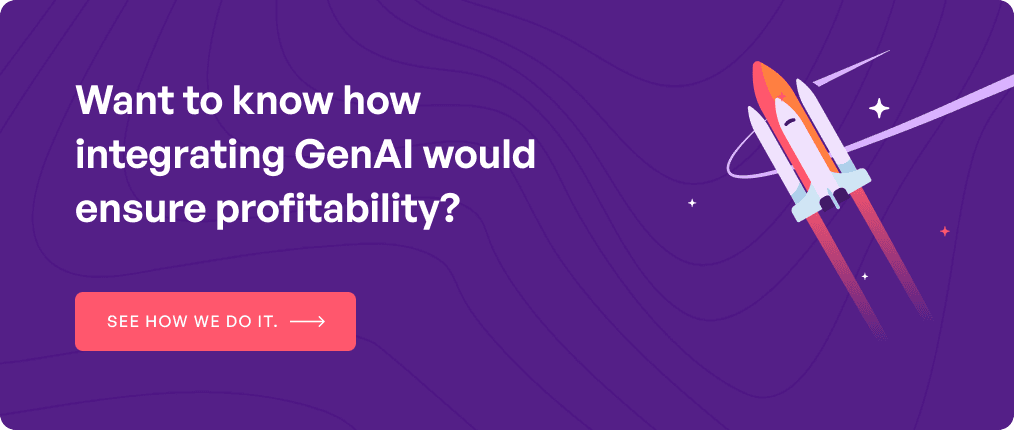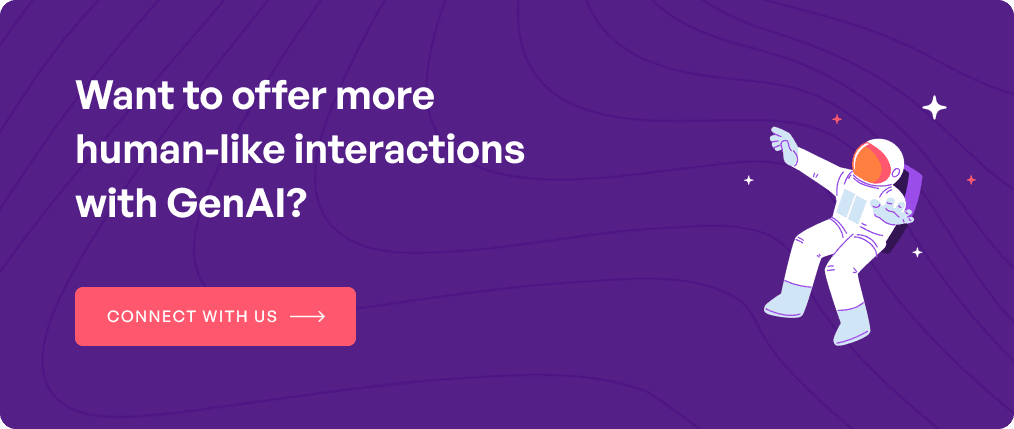Generative AI has significant potential to rewrite the global economy. Its power and capabilities are reflected in the huge variety of tasks that it can assist in. The popularity of GenAI reached a new milestone with ChatGPT, GitHub Copilot, and Gemini and the adoption rates exploded across the globe. From a novel technology, it slowly witnessed mass application worldwide. Wondering why? Well, GenAI helps with content creation, coding, personalization, rapid prototyping, chatbots creation, software development, data augmentation, fraud detection, and privacy. It can also automate 70% of human tasks and analyze both fragmented and unstructured data.
Long story short, this technology helps workers do more with less and unleash a wave of productivity. This boosts revenue and supports an increase in profits. The statistics from a Microsoft sponsored study offer a compelling insight on this. It found that a company receives $3.5 ROI for every $1 that is invested on AI. GDP can also rise between 1.8% to 4% by 2032 depending on the adoption rate. Overall, integrating generative AI in your system can result in substantial organizational transformation and promising gains.
This article gives you all possible details about how to integrate generative AI into your existing application. Read on to make informed choices in your project.
Table of contents
What are the business benefits of integrating generative AI in a system or software?
Over 80% of enterprises will deploy GenAI based applications in production environments and adopt GenAI in APIs in 2024. So, there’s no doubt that when humans and machines work hand-in-hand, the possibilities to upscale a business will be immense. Industries like healthcare, fintech, SaaS, education, entertainment, and tourism can widely benefit from its transformative role in the coming years.
Let’s explore how to leverage this technology in a mobile app development project to increase the chances of client satisfaction, boost sales, and lower the dependency on human employees.
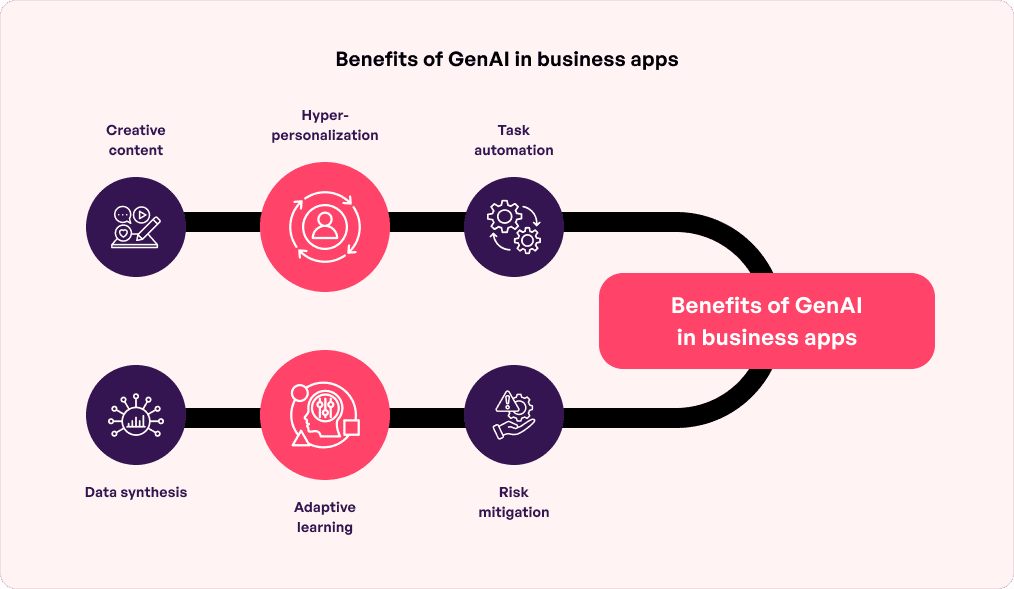
Creative content
The primary work of GenAI is generating software codes, texts, and visual designs. This is done by interpreting prompts in the form of images, videos, speech, music, texts, and codes. Other practical GenAI applications include answering questions, tone manipulation, content classifications, content simplification, improving chatbot performance, and summarizing content like mails. So, it is a good idea to consider generative AI integration services to satisfy existing customer demand accurately and consistently without errors and fatigue.
Hyper-personalization
Personalization using GenAI can cause a paradigm shift in customer services. Over 70% of digital retailers in the US believe that AI-driven personalization might impact business in 2024. This is because the technology can analyze big sets of customer data which accurately helps in identifying needs, preferences, intent, and sentiments.
Through the technology’s help, developers can get into customers’ minds to tailor relevant and engaging interfaces, responses, and interactions. It can be in the form of emails or product recommendations which fosters a deeper connection between the brand and its audience. Visual AI, augmented reality, and concierge solutions also help. Visual AI teaches a sense of images and visual objects, AR offers virtual ‘try-ons’ which elevates the online shopping experience, and concierge solutions help with product recommendations. Ultimately, this allows a friction-free customer journey and leaves a lasting impression.
Task automation
GenAI can respond to user queries using the internet. However, when paired with Robotic Process Automation, it can offer powerful automation solutions as well. This includes image and document processing, data processing, responsive chatbots, AI-driven decision making, and interpreting social media comments and taking the necessary actions. Other use cases could be automated data entry and validation, discover healthcare data analytics, intelligent automation, loan application process, report generation, supply chain optimization, intelligent ticket routing, A/B testing, customer segmentation, and fraud detection.
Risk mitigation
Generative AI helps connect the dots between actionable data and cyber breaches. It can help with cybersecurity by identifying faulty codes and then monitoring and analyzing threats in real-time. But how is it done? Well, genAI can interpret suspicious patterns and wade through the entire neural network to spot any vulnerabilities or gaps. Now it uses machine learning and similar AI tools to respond to existing and evolving hazards. In short, AI in data privacy has a significant role to play to improve operations and revenue.
Adaptive learning
GenAI is able to learn and adapt based on feedback, which helps the model align well with the user objectives and preference. For instance, Edtech platforms can deploy generative AI to enable adaptive learning and get an idea of a student’s learning curve. This helps provide a personalized experience to students. The phenomenon is mainly guided by algorithms which help to cater to the unique learning pace and preferences. With this benefit, developers can also make sure the model automatically improves regularly, based on real reviews and ratings.
Data synthesis
GenAI can analyze market trends, economic indicators, and consumer behavior and attitude. This helps ‘synthesize’ large sets of data, predict insights and deliver information. It can be then used to make important decisions regarding capital allocation, resource usage, or even investments to gain a competitive edge. Synthesized AI data can additionally be used for database generation, subsetting, and intelligent masking. This benefit, however, is not restricted to a specific industry. All sectors that are ready for the generative AI integration process can unlock actionable data to help businesses flourish in a data-driven ecosystem.
All the above tech-powered benefits combined can ensure speed, accuracy, productivity, efficiency, and sustainability in a business. So, it is a good idea to get in touch with a generative AI development company like Simublade in Houston. Our experts offer integration of GenAI by prioritizing data centricity and mixing a wide variety of languages and frameworks to help achieve business goals 5X faster. You can read more about the generative AI integration services for a clear picture.
What is the integration process of generative AI?
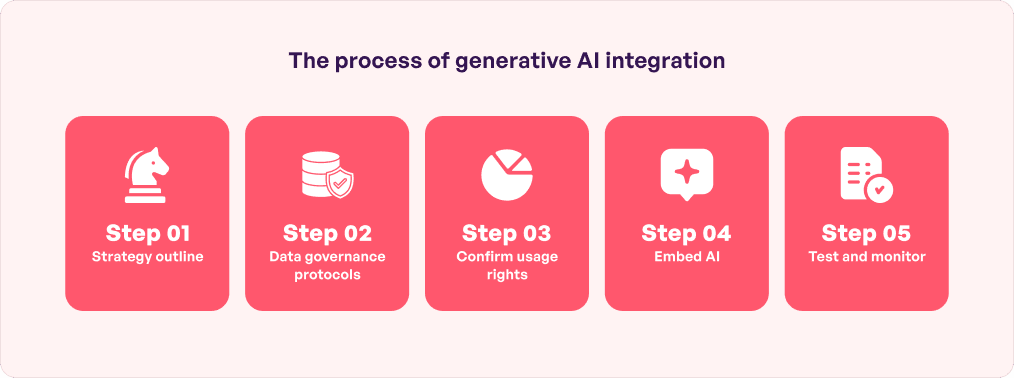 The best approach to the integration process of generative AI is to outsource it to an AI-expert. However, you must have a clear idea of how it is done for clarity and transparency while being able to estimate a budget too. Read on to find out in detail.
The best approach to the integration process of generative AI is to outsource it to an AI-expert. However, you must have a clear idea of how it is done for clarity and transparency while being able to estimate a budget too. Read on to find out in detail.
Identify your needs
A study found that GenAI typically delivers results in marketing and sales, client operations, research and development, and building software. Consider performing a careful analysis of where you require it. Further, ask this to yourself : where else would GenAI make the biggest impact in my business? The answer will help you get a clear idea of your additional needs and pain points. Through this exercise, you will also be able to pick areas that have the potential for improvement. Simply convey this to the development team and here’s what they will do next.
Gather data requirements
Once the developers have a clear idea of your needs, they look for the relevant and sophisticated training data which is the lifeblood of AI. This is based on model complexity, error handling, set of features, and the problem that the AI is trying to solve. Further, the developers also have to provide information-rich examples for the training model to identify patterns. It is also necessary for making predictions and or performing tasks.
Data preparation is the next step in which cleaning and processing are done, here the unstructured data is structured and made accessible via tagging, labeling, and cataloging. This process is automated using the best algorithms for accuracy, scalability, and consistency.
Appropriate AI model
Developers will pick the right AI model according to business or project goals. This typically includes natural language processing, voice recognition, or machine learning. Developers might look for the following before finalizing:
- explainability
- fine precision
- future-proofing
- business scalability
- outputs quality
- overall performance
The AI or machine learning model is also assessed in terms of complexity, regularization methods, ensemble methods, and interpretability. Once all of these are done, the developers then take the work ahead.
The right tools, tech stack, and frameworks
This is one of the most crucial steps in the generative AI integration process since this forms the base of the entire project. Developers will pick artificial intelligence frameworks like PyTorch and TensorFlow. Pre-built AI tools might also be used like AWS SageMaker and Kuberflow for smooth integration. Using AI in software development and integration processes helps you win in the competitive space.
Create development environment
The developers will update the local development environment that contains cloud compute, terminal and shell tool, notebook environments, and prompt eng. tooling. Further, AI/ML libraries and packages are also required including Hugging Face, Transformers, Gradio, Diffusers, and Axolotl and PEFT. The usage will typically depend on the scale and scope of the project and can be modified accordingly.
AI model training
The basics of training an AI means walking a computer program through a continuous intelligence-gaining process. Simultaneously, changes are made to tune their intended functions which are closely aligned with pre-decided requirements. Further, GPT models apply deep learning algorithms to LLMs for gathering knowledge about a topic and interact confidently with minimal errors. Overall, these efforts ensure the final product is able to work without human dependency.
It is important to note, however, that the time taken to train the model can be weeks or hours, depending on the number of tokens included in the dataset.
AI integration
This is when the real integration process of generative AI begins since the refined AI components will now be embedded in the existing codebase. Below are the next steps:
Step 1: The best engineers, like the ones at Simublade, firstly outline a strategy with APIs and SDKs containing plans, goals, tools and technologies to be used, and the end-to-end monitoring process. This ensures all major functions are able to interact consistently with the system’s features.
Step 2: Next, data governance protocols are put in place that includes security, monitoring, and permission access.
Step 3: Relevant usage rights are also considered to avoid third-party disputes. The developers further build an efficient environment to interpret and utilize AI outputs.
Overall, it can optimize the user-experience and performance to benefit end-users.
These were the main stages of the generative AI integration process. After this, the developers carry out the basics – testing, monitoring, optimizing, and checking for both ethical and legal considerations to avoid lawsuits and tarnished reputation.
What are the challenges of integrating generative AI into apps or software?
Generative AI comes with a multitude of benefits. However, developers need to overcome a few obstacles to help the technology reach its highest potential. Here’s a look at the challenges and how these can be prevented.
Data privacy concerns
GenAI is trained using vase dataset and some of it could contain sensitive and confidential information. Any kind of abuse can have far-fetched implications that can escalate to lawsuits and penalties. Otherwise too, it can lead to significant damage like loss of customer trust and reputation damage. Stakeholders can also withdraw their investment in your company.
The best way to avoid data leaks or abuse during the integration process of generative AI is adding robust protection measures. It is important since the global annual cost of cybersecurity is expected to reach $9.5 trillion in 2024 alone. So, the best developers typically deploy multiple layers of encryption, conduct regular security testing, and monitor the access controls.
Quality of inputs
Generative AI is completely shaped by the data it is trained on. So, developers have to make sure that something similar to the Google Gorilla Problem does not occur. It was an incident where Google Photos labeled a Black couple as Gorilla. It triggered the people of the internet and hell broke loose around racist algorithms. Problems like these happen when the data is biased, not sensitive towards the community, or supports racism, which altogether, becomes unreliable and harmful. To solve this, developers usually consider data audits where the information is ‘sanitized’ end-to-end and only then it is used to train the GenAI model to avoid controversies.
Content authenticity
The GenAI content should not be the same as someone else’s work. Because then the product is a threat to the original piece and it will automatically attract copyright infringement issues now or later. Therefore, it is necessary to ask for permission or confirm the usability of data. Developers could also think of a partnership with the original creator to ensure ethical and legal compliance before they integrate generative AI into your existing application. This careful consideration helps ensure high-quality and valuable inputs and outputs that meet the ‘par score’. Overall, the end-result is fair, reliable, and accurate.
Integration challenges
Google Cloud findings say that 40% of executives have an urgency to integrate GenAI without the company’s complete readiness. However, this could be a problem since APIs will not be able to facilitate smooth interactions because the system architecture is not compatible with the AI model yet. The existing product ends up with hurdles while functioning and disrupts business operations.
So, let developers from the best AI app development company take over. They perform clear documentation, versioning, and error management. All types of technology gaps and security loopholes are also closed. Altogether, the GenAI model is seamlessly blended with your application or software for the best-in-class functionality.
How much is the cost of GenAI integration?
The initial GenAI integration cost is roughly between $37,000 to $100,000. This will include the storage setup, hardware, and anything related to the deployment. You would also have to pay for recurring data management, maintenance, and ongoing integration needs which is around $7,000 and $20,000.
A good way to get a clearer approximation is to know the cost to develop generative AI. This helps offer an end-to-end idea of investing in the technology. Further, know that the integration costs depend on model complexity, data size,GPU type (high-end or basic), maintenance requirements, and the size of the enterprise.
What are the legal and ethical considerations of integrating generative AI into apps or software?
Navigating both the ethical and legal dimensions is critical when dealing with a highly transformative force like GenAI. How is it done? Read in detail:
Legal considerations
Developers must maintain strict compliance with the existing legal frameworks concerning AI like the European Union (EU) General Data Protection Regulation (GDPR) and the Artificial Intelligence Act (EU AI Act). These acts have laid down the guidelines on data privacy, security, and usability. Following them is of utmost importance to ensure the technologies are correctly utilized in a business landscape.

Ethical considerations
On the other hand, AI ethics like fairness, transparency, and accountability are equally important to position yourself as a trusted brand. Developers make sure that the training data has no sensitive or racist content that intends harm. There should be no biased outputs that create public outrage and damage your business reputation.
How does hiring developers from Simublade for generative AI integration services help businesses?
Hiring the best developer can be a game changer for your business. All you have to do is shortlist the best one, convey your goals and objectives of the GenAI integration, and leave it to the developers to execute your vision. This is where we come in.
At Simublade, we strive to take your idea to the global smartphone market. Our tried and tested processes include concept finalization, development, integration, and deployment for end-to-end client satisfaction. Below is a list of why we could be your best GenAI integration partner so you outshine competitors and scale your business to a global scale.
Tech stack
We work hard to bringforth groundbreaking innovation with a robust tech-stack. So, we offer learning frameworks, generative AI models, toolkits, libraries, image classification models, and neural networks to create a significant impact on your business. For instance, expertise and experience in the latest technologies helped us deliver several ncredible projects like Tavus, DoughFi, and Opar to name a few.
However, in the world of artificial intelligence, having technical prowess is just the tip of the iceberg. So, the next set of qualities are also critical to consider when hiring developers.
Core skills
Our developers have a mastery in machine learning, predictive analysis, data capture, natural language processing, computer vision, and sentiment analysis. However, we are second to none when it comes to diverse AI integration services. This includes:
- generative AI development and integration
- data exploration for the scope of refinement
- PoC development by continuously algorithm training
- AI chatbot development for natural conversations
- automation-based solutions for multiple tasks
- custom AI solutions development, and
- strategy consulting for AI integration and execution
So, rest assured we are well-equipped with all possible AI-requirements that might arise during a generative AI integration process. You can check out project portfolios and compare with fellow brands for an informed decision.
Soft skills
Our developers are friendly, attentive, and considerate. They have immense problem solving, AI ethics and bias mitigation, communication, and collaboration skills. Further, the professionals are up to date with the latest trends and have a continuous learning and growth mindset. They are willing to adopt new methodologies, if required, that fit your pain points and finally align expectations and goals. Ultimately, they work in your best interest rather than with a profit-hungry approach.
Budget-friendly
Hire developers at a reasonable rate, starting at $12/hr. The price will depend on several factors like data complexity, business and industry needs, technologies required, and the developers’ skills and techniques. You, as a business, must carefully analyze their current expertise along with their skills, techniques, and creativity to make a decision.
It does not hurt to get a comprehensive understanding of GenAI before integrating it in your system. So, being responsible business owners, read and research about this captivating technology, participate in online forums, share knowledge, and discuss with your stakeholders. See how you can maximize its potential to ensure measurable outcomes. Back this homework with the best AI engineers and developers, like the ones at Simublade, to promote growth and innovation in your organization.
FAQs
Q. What are the benefits of integrating generative AI into an app?
Ans. Integrating generative AI into apps helps offer valuable customer insights. It gives an idea of their purchasing pattern, behavior, and preferences. Businesses can also leverage clustering and segmentation to discover new opportunities to tap on to potential leads. Detecting suspicious activities or anomalies is another fantastic benefit of integrating GenAI.
Q. How long does it take to integrate generative AI into an app?
Ans. The generative AI integration process takes around 3 weeks or might go up to a few months. The time frame typically depends on the model’s data set, training process, algorithm complexity, and developers’ expertise.
Q. How much does it cost to integrate generative AI into your existing app?
Ans. The initial GenAI deployment cost is around $37,000 to $100,000. Further, you have to pay for data management and maintenance which sums up to roughly $7,000 and $20,000. Conveying your needs to developers will help you get the best cost idea.
Q. Why should you choose Simublade for GenAI integration?
Ans. Simublade is a trusted AI development company in Houston, Texas. Our experts offer future-proof solutions and help achieve business goals by 5X. With AI mastery at our disposal, we innovate with deep learning frameworks, toolkits, neural networks, and image classification models to transform your business. So, our integration process of generative AI builds a foundation for an efficient and intelligent ongoing process.
Q. How can generative AI integration benefit your business?
Ans. Hyper-personalization, automation, adaptive learning, creative content, data synthesis, and risk mitigation are the top generative AI integration benefits in business.


